Finally, the action taking place within the
"ceremonial" reliefs exhibit the power and importance of the
king. First off, the panels depicting the deities fertilizing the
sacred tree are important. The sacred tree is shown artistically
in a symmetrical manner with intertwining branches, stylized
leaves, and a fan of leaves above the trunk. The winged geniuses
are fertilizing the sacred tree with a date blossom in their
right hand and holding a sacred bucket in their left. In
addition, panel three shows a winged deity following
Assurnasirpal with his right hand raised over the king "in a
gesture of benediction and divine protection" (Art History
Anthology 28). By placing these reliefs in his antechamber and
living room, Assurnasirpal "emphasizes the sacred character of
the Assyrian king, elected by the gods, although not himself of
divine substance" (Frankfort 87).
In conclusion, we find that the reliefs from the palace of King
Assurnasirpal II play an important role in exhibiting the power
and importance of the king. While an Assyrian king's power can be
depicted is a war-like manner by his military might, we learn
that "ceremonial" reliefs are also effective by placing the king
in relation to gods. The power and importance of the king is
shown through a peaceful manner that highly contrasts the scenes
of death and fighting found in such reliefs as the lion hunt of
Assurbanipal and the battle scene of Assurnasirpal.
Nimrud (ancient Kalhu), northern Iraq
Neo-Assyrian, about 730-727 BC
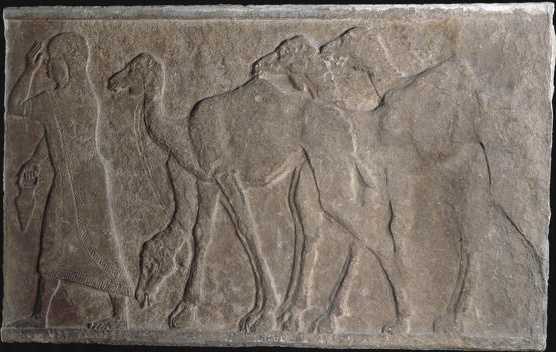
Stone panel from the Central Palace of Tiglath-pileser III
A successful Assyrian campaign against the Arabs
This alabaster panel decorated the mud-brick walls of the Central Palace of King
Tiglath-pileser III (reigned 745-727 BC). It is one of a series of panels that
depicts a procession of prisoners and booty captured during one of the king's
campaigns against Arab enemies.
A woman leads a herd of camels. The one-humped camel, or dromedary, was probably
domesticated by the inhabitants of Arabia at the end of the second millennium BC.
Under Tiglath-pileser the administration of defeated territory was reorganized
by extending direct Assyrian rule over them, transforming them into provinces of
an empire. These provinces included territory as far west as Damascus.
Increasingly Assyrian kings came into conflict with Arabs.
The Arabs first appear in Assyrian records in the ninth century BC. Assyrian
texts tell of Arab tribes led by queens, and show how they became increasingly
important for escorting trading caravans or military expeditions in northern Arabia and Sinai.
Height: 99 cm Width: 162 cm
 
Nineveh [Ninive] (Iraq)
The site of Nineveh lies on the east bank of the
River Tigris. The ancient tell, now known as Tell Kuyunjik, was
occupied from the seventh millennium BC. A deep excavation at the
site, carried out by Max Mallowan, established a chronology
against which many of the other sites in north Mesopotamia are
compared.
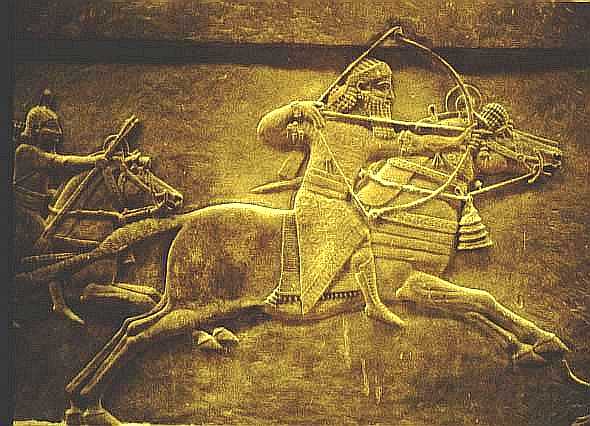
In the later second millennium BC, Nineveh was an important city
with a prestigious temple of the goddess Ishtar. Sennacherib
chose it as his capital and laid out a city surrounded by walls
approximately twelve kilometres in circumference. The old tell
formed the main citadel and was where, at the beginning of the
seventh century BC, Sennacherib built the so-called Southwest
Palace, decorating it with carved stone reliefs. As at Nimrud and
Khorsabad, there was also an arsenal. This was situated on the
river wall south of the citadel mound at Tell Nebi Yunus
(so-called because later legend claimed this was the tomb of the
prophet Jonah). Ashurbanipal built a second palace on Tell
Kuyunjik, the North Palace, which contained the famous lion hunt
reliefs. In the summer of 612 BC, Nineveh fell to the combined
forces of the Medes and Babylonians. Occupation continued,
however, for a further 1000 years before Nineveh was eclipsed by
the city of Mosul, on the other side of the river.

Nineveh (Ninive), northern Iraq
Neo-Assyrian, about 700-681 BC
Stone panels from the South-West Palace of
Sennacherib
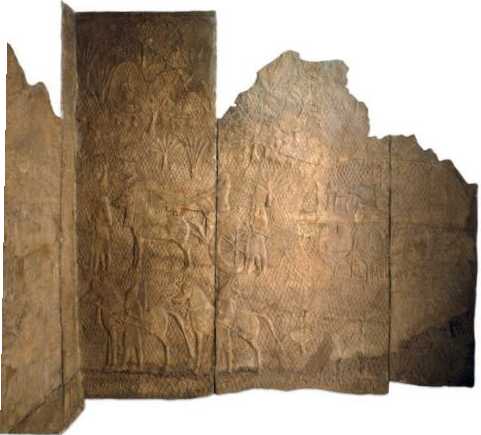
The siege and capture of the city of Lachish, in the kingdom
of Judah, in 701 BC
Length: 172 cm Width: 61 cm
These alabaster panels were part of a series which decorated the
walls of a room in the palace of King Sennacherib (reigned
704-681 BC).
These three surviving slabs complete the royal entourage. The
right-hand end shows more cavalry and chariots waiting behind the
king. It also shows an aerial view of the Assyrian camp with its
oval wall and defensive towers at intervals shown flattened out.
Other Assyrian camps shown on reliefs were sometimes round or
rectangular. The camp seems to have been methodically planned
with a road running through the middle. There are two pavilions,
like the one behind the king, and five open tents in which
various activities can be seen, including the amusing scene of
two men gossiping over a drink. The pair of chariots in one
corner of the camp have a standard in each of them; these are the
chariots of the gods, sometimes seen charging in battle. On this
occasion two priests in tall hats are performing a ceremony; an
incense burner stands higher than the priests, and a sacrificial
leg of meat sits on an altar.
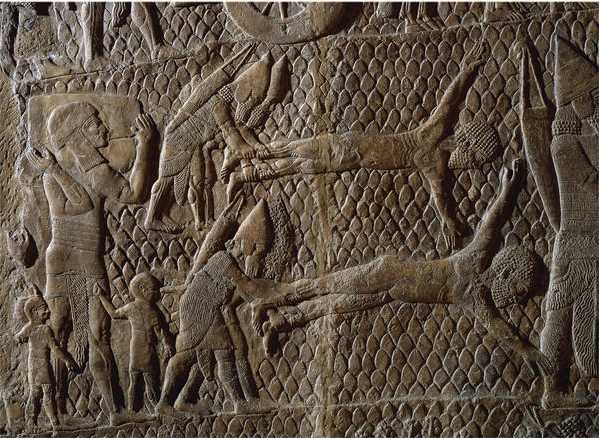
The siege and capture of the city of Lachish in 701 BC
Length: 269 cm Width: 180 cm
Having been exiled from their city, the people of Lachish move through the
countryside to be resettled elsewhere in the Assyrian Empire. Below them high
officials and foreigners are being tortured and executed. It is likely that
they are being flayed alive. The foreigners are possibly officers from Nubia.
The Nubians were seen as sharing responsibility for the rebellion. Much of Egypt
at this time was ruled by a line of kings from Nubia (the Twenty-fifth Dynasty)
who were keen to interfere in the politics of the Levant, to contain the threat
of Assyrian expansion. As Sennacherib's forces laid siege to Lachish, an Egyptian
army appeared, led by a man called Taharqa, according to the Old Testament.
He may be the later pharaoh of Egypt with the same name (690-664 BC).
Sennacherib's account claims that the rebels had called on the support of
the kings of Egypt (Delta princes) and the Kings of Kush (Nubia).
The armies clashed on the plain of Eltekeh. While Sennacherib claimed victory,
he was still not able to capture Jerusalem.

Nineveh, northern Iraq
Neo-Assyrian, about 645 BC
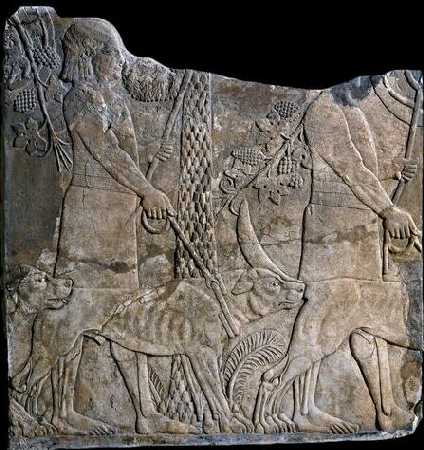
Stone panel from the North Palace of Ashurbanipal
Hunting with hounds
This stone panel decorated a mud brick wall of the palace of
King Ashurbanipal (reigned 669-630 BC) at Nineveh. It was
originally part of a much longer composition relating to the
royal sport of lion hunting. The figures leading the hounds are
hunt attendants.
The use of such mastiffs is well represented on the wall reliefs
at Nineveh. They are used to guard the edge of an arena in which
the king kills lions and, in a separate hunting composition, they
are used to bring down wild asses. Scenes of hunting are a common
motif in Mesopotamian art reflecting the king's conquest of
chaotic and dangerous nature.
Dogs may have been the earliest animals to be domesticated by
humans, perhaps by 10,000 BC or earlier. In Mesopotamia some of
the earliest evidence for the presence of dogs comes in the form
of skeletons found in the graves at Eridu in the south and dating
to around 5000 BC. They have been identified as greyhounds.
It has been suggested that the disease of rabies was present in
Mesopotamia by the beginning of the second millennium BC and
representations of dogs, possibly for magic protection, make
their appearance.
The Mesopotamians considered the dog family to include not only
domestic dogs, wolves, hyenas and jackals, but also lions.
Height: 107 cm (approx.)
Width: 102cm (approx.)
Depth: 18cm (approx.)

Nineveh, northern Iraq
Neo-Assyrian, around 645 BC
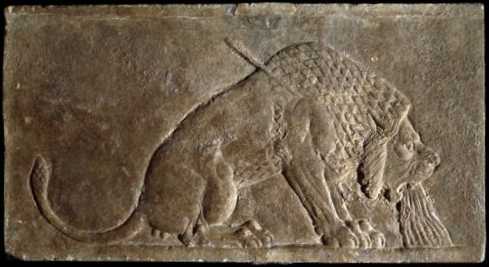
The Dying Lion, a stone panel from the North Palace of
Ashurbanipal
The triumph of the Assyrian king over nature
This small alabaster panel was part of a series of wall panels
that showed a royal hunt. It has long been acclaimed as a
masterpiece; the skill of the Assyrian artist in the observation
and realistic portrayal of the animal is clear.
Struck by one of the king's arrows, blood gushes from the lion's
mouth. Veins stand out on its face. From a modern viewpoint, it
is tempting to think that the artist sympathized with the dying
animal. However, lions were regarded as symbolizing everything
that was hostile to urban civilization and it is more probable
that the viewer was meant to laugh, not cry.
There was a very long tradition of royal lion hunts in
Mesopotamia, with similar scenes known from the late fourth
millennium BC. The connection between kingship and lions was
probably brought to western Europe as a result of the crusades in
the twelfth and thirteenth centuries AD, when lions begin to
decorate royal coats of arms.
Height: 16.5 cm
Width: 30 cm

Neo-Assyrian, 7th century BC
From Nineveh, northern Iraq
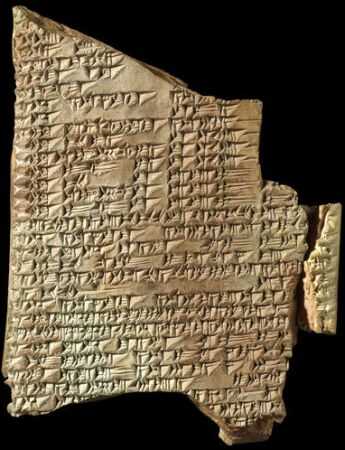
Tablet telling the legend of Etana
Part of the library of King Ashurbanipal (reigned 669-631
BC)
The story told on this tablet centres on Etana, a legendary king
of the southern Mesopotamian city of Kish.
An eagle has its nest in the branches of a tree while a snake
nests at its base. The two animals swear an oath of friendship by
Shamash, god of the sun and justice. They both raise their young,
but the eagle eats the young snakes. The snake cries to Shamash
who tells it to hide in the carcass of a dead wild bull. The
eagle flies down to eat from the bull, but is seized by the
snake, who ties its wings and throws it into a pit.
Meanwhile, Etana, a pious man, prays to Shamash for a son and
the plant of life. Shamash tells Etana where to find the eagle,
so that it can help him to find the plant. For seven months Etana
teaches the eagle how to fly again. But the eagle is unable to
find the plant, and suggests that they fly up to heaven to speak
with the goddess Ishtar. Etana is frightened by the height they
fly and they have to make several attempts at the journey.
We do not know whether they were successful, as unfortunately
the rest of the text is missing and the end of the story is
unclear. Versions of the legend are known from as early as the
seventeenth century BC, but the story is certainly much
older.

Neo-Assyrian, 7th century BC
From Nineveh, northern Iraq
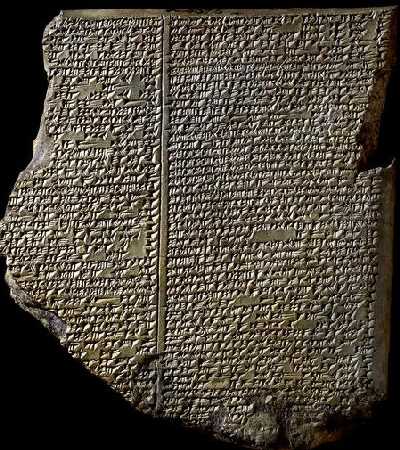
The Flood Tablet, relating part of the Epic of
Gilgamesh
The most famous cuneiform tablet from Mesopotamia
The Assyrian King Ashurbanipal (reigned 669-631 BC) collected a
library of thousands of cuneiform tablets in his palace at
Nineveh. They recorded myths, legends and scientific information.
Among them was the story of the adventures of Gilgamesh, a
legendary ruler of Uruk, and his search for immortality. The Epic
of Gilgamesh is a huge work, the longest literary work in
Akkadian (the language of Babylonia and Assyria). It was widely
known, with versions also found at Hattusas, capital of the
Hittites, and Megiddo in the Levant.
This, the eleventh tablet of the epic, describes the meeting of
Gilgamesh with Utnapishtim. Like Noah in the Hebrew Bible,
Utnapishtim had been forewarned of a plan by the gods to send a
great flood. He built a boat and loaded it with everything he
could find. Utnapishtim survived the flood for six days while
mankind was destroyed, before landing on a mountain called
Nimush. He released a dove and a swallow but they did not find
dry land to rest on, and returned. Finally a raven that he
released did not return, showing that the waters must have
receded.
This Assyrian version of the Old Testament flood story was
identified in 1872 by George Smith, an assistant in The British
Museum. On reading the text he
" ... jumped up and rushed about the room in a great state of
excitement, and, to the astonishment of those present, began to
undress himself."
Length: 15 cm
Width: 13 cm
Thickness: 3 cm

|


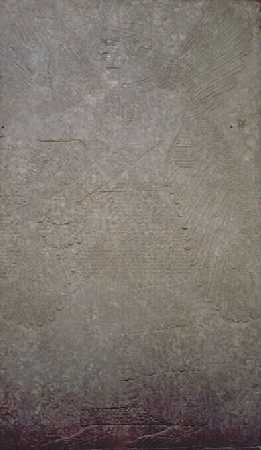
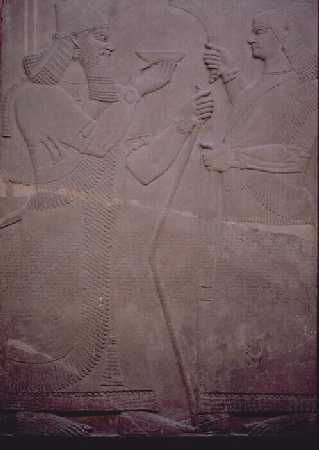
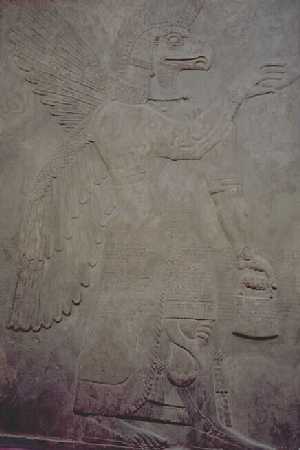








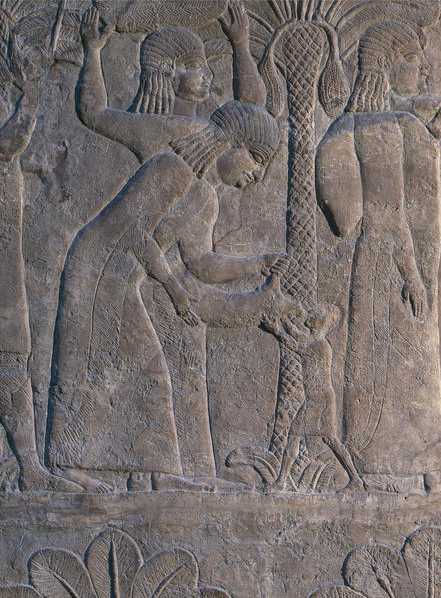
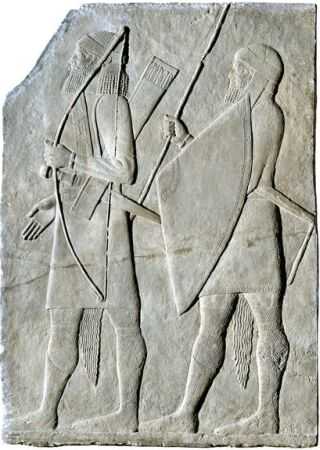
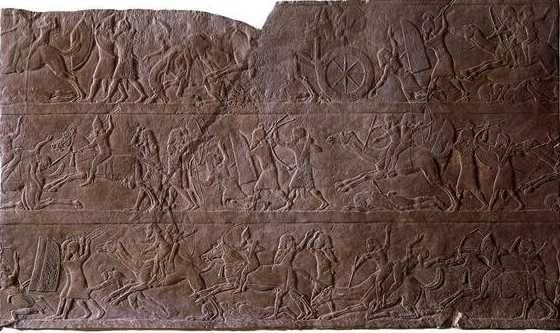
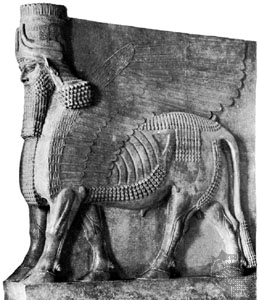 "In this magnificent edifice I had opened no less than
twenty-one halls, chambers, and passages, whose walls, almost
without exception, had been paneled with slabs of sculptured
alabaster recording the wars, the triumphs, and the great deeds
of the Assyrian King (Sennacherib). By rough calculation, about
9880 feet, or nearly two miles, of bas- reliefs, with
twenty-seven portals, formed by colossal winged bulls and lion
sphinxes were uncovered" (TCOLBS 66)
"In this magnificent edifice I had opened no less than
twenty-one halls, chambers, and passages, whose walls, almost
without exception, had been paneled with slabs of sculptured
alabaster recording the wars, the triumphs, and the great deeds
of the Assyrian King (Sennacherib). By rough calculation, about
9880 feet, or nearly two miles, of bas- reliefs, with
twenty-seven portals, formed by colossal winged bulls and lion
sphinxes were uncovered" (TCOLBS 66)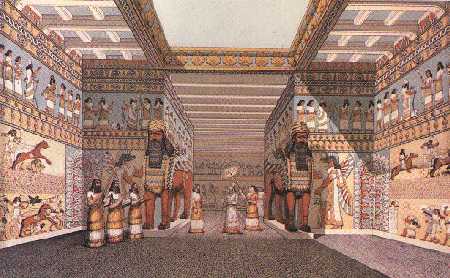 In the 1st slab many
different types of archers and slingers are depicted, as the
Assyrian army was made up of many different ethnic groups pressed
into service this is possible. The archaeological evidence at the
site that supports the idea of many different groups, as depicted
in the reliefs is they fact that as many as 30 different styles
of arrow heads are found stuck into the destruction rubble at
level 3 of the tell. (BASOR) Most of the arrow heads are Iron,
but copper and even bone arrowheads are mixed into the bunch. The
bone arrowheads are probably just a contaminate to the
record.
In the 1st slab many
different types of archers and slingers are depicted, as the
Assyrian army was made up of many different ethnic groups pressed
into service this is possible. The archaeological evidence at the
site that supports the idea of many different groups, as depicted
in the reliefs is they fact that as many as 30 different styles
of arrow heads are found stuck into the destruction rubble at
level 3 of the tell. (BASOR) Most of the arrow heads are Iron,
but copper and even bone arrowheads are mixed into the bunch. The
bone arrowheads are probably just a contaminate to the
record.